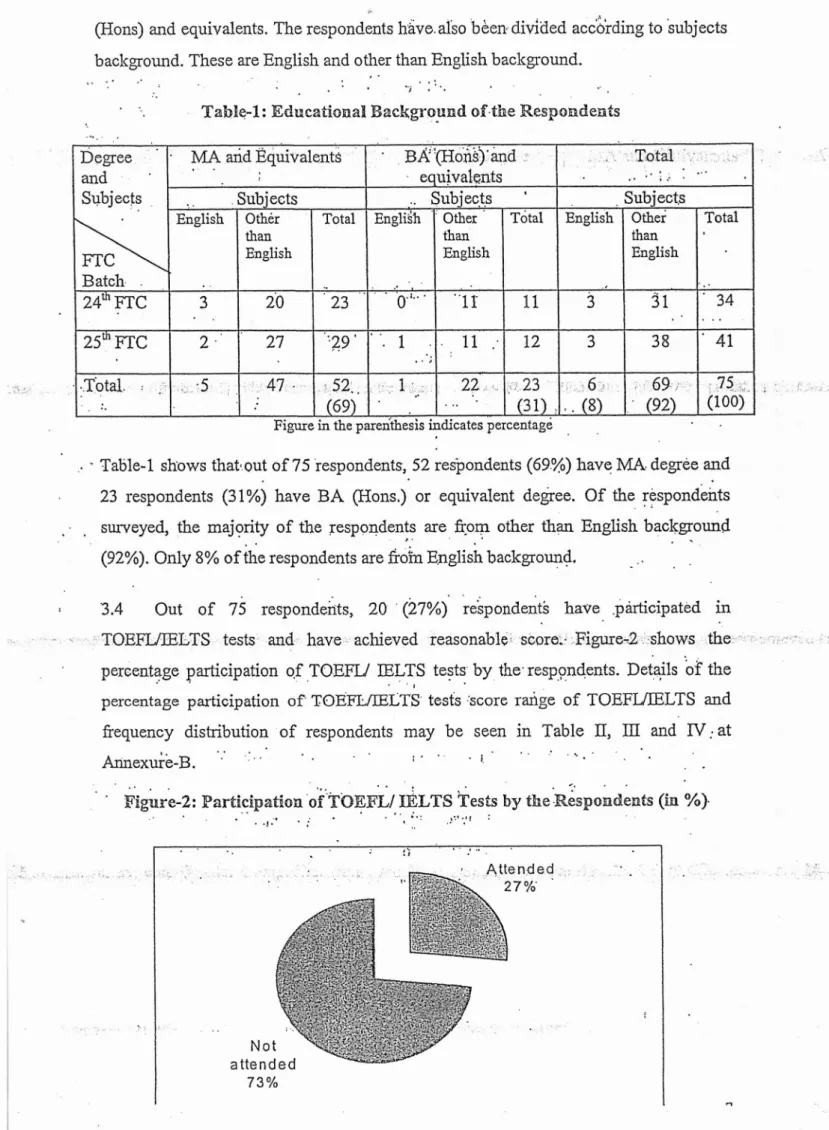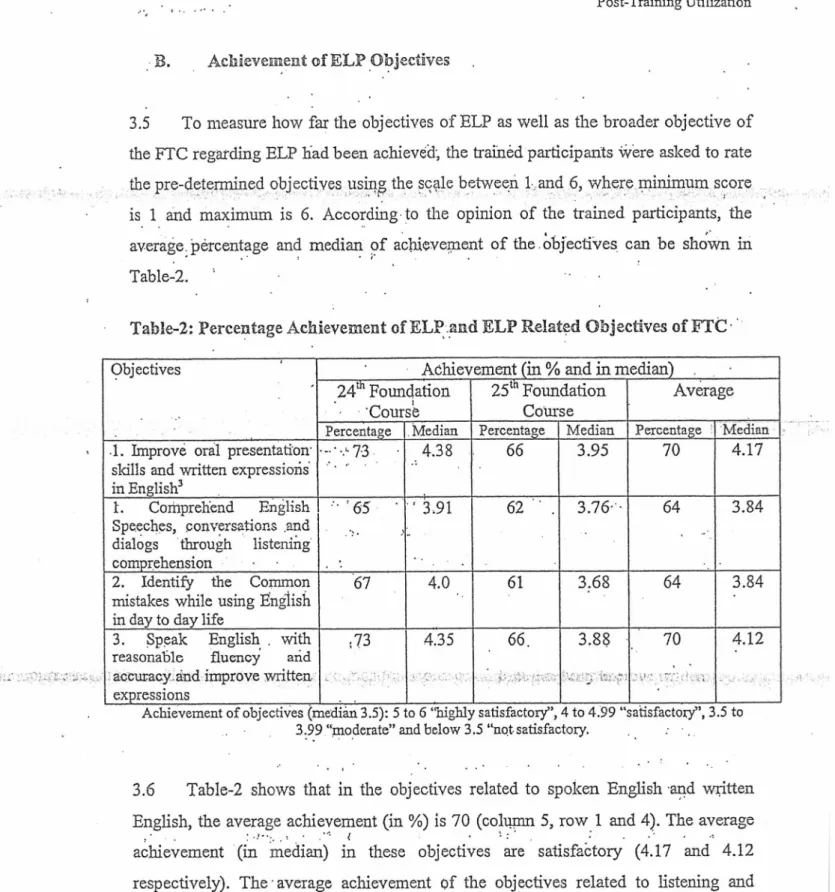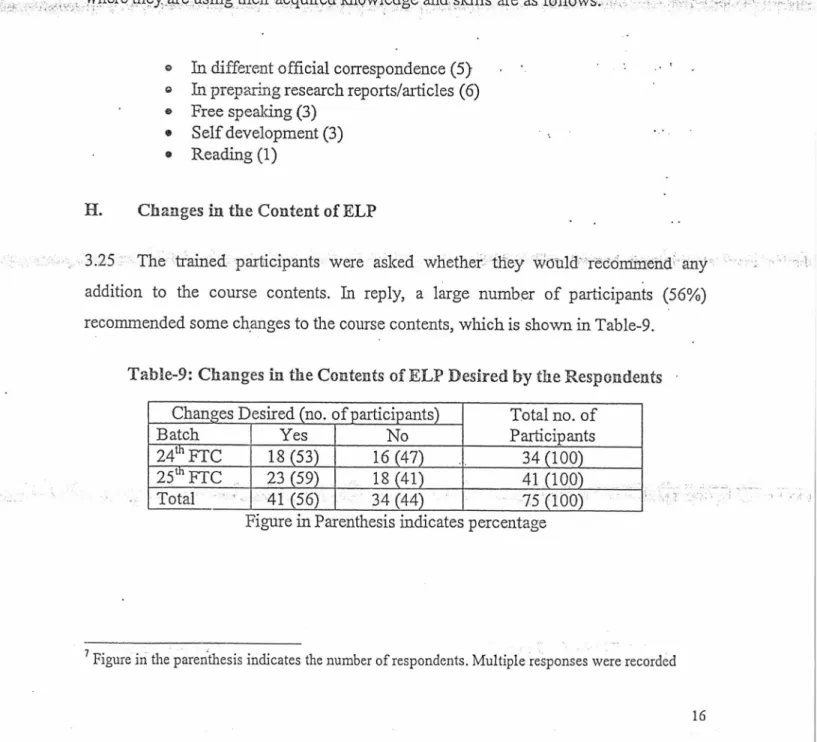Researchers have attempted to measure the outcome of training by analyzing responses to all specific study questions. So the study reflects the views of selected samples, not the entire population. Therefore, it would not be wrong to say that the selection of respondents was rational to find out the result after the ELP training of FTC.
7 The researchers analyzed the findings for each of the specific questions of the study objectives. In most cases, the level of knowledge before the training was not satisfactory (average values were below 3.5). The finding shows that 13% of the participants were fully successful and 70% of them were partially successful to apply their knowledge and skills in their workplaces.
The findings show that group respondents belonging to BCS (Economics), BCS (Information) and BPATC are more successful in using the knowledge gained and. Based on the findings, the researchers have formulated recommendations, which can be divided into two categories.
INTRODUCTION
Whether they experience any barriers or obstacles to utilizing the acquired knowledge, skills and attitude in daily work. iv) Whether course curriculum should be changed which will make the ELP more effective.
Hypothesis
Methodology of the Study
Another reason is, after completing these two courses, the participants have passed a significant amount of time in the field, which is essential to have the study on post-training utilization. The main sources of secondary data were the end-of-course evaluation reports of the relevant courses and. The data was also presented in the report in tabular form and in the form of maps and graphs (histogram and pie charts).
In this study, an attempt has been made to find out whether the participants' knowledge and skills in English have increased, and whether their attitudes towards. The study has also tried to find out whether they use the acquired knowledge and skills in their workplaces. It would have enriched the study if the researchers could analyze the job descriptions of the trained officers in pre- and post-training situations and if they would try to find out the correlation.
The researchers attempted to measure the outcome of the training by analyzing the responses to all specific questions of the study objectives. Therefore, when determining the use of the English module in the workplace, the findings of the survey may be influenced by the respondents' opinions about these personnel.
TI. CONCEPTUAL FRAMEWORI( OF THE STUDY
Comparison between level of knowledge and skills before and after training
The mean level of knowledge on the spoken English head before training was 61 in % and 3.68 in median (Table-4). The average level of acquired knowledge on the spoken English head after training has increased to 73% and in the median 4.38, which is 12 percent. Table-4: Comparison between pre- and post-education level of knowledge and skills under four main areas and their applications (in % and in median)".
Major heads Knowledge level Knowledge level Level of application before FTC after FTC Knowledge. Table V of Appendix B shows that the level of knowledge for all subjects increased after attending FfC. The mean level of acquired knowledge in Listening Comprehension after attending the FTC increased to 72 in% and 4.27 in the median, and is 14 percentage points higher than that of the level before attending the FfC (Table 4 ).
It appears from table-V in appendix-B that the level of knowledge has increased for all the subjects after participating in FfC. The average level of knowledge on the structure and writing comprehension section before training was 60 in % and in 3.51 median (table-4). The average level of acquired knowledge on the structure and written comprehension subject after training has increased to 71 in·%.
Table V of Appendix B shows that the level of knowledge increased for all topics after FTC. The average level of knowledge gained on the Style post-training increased to 71% and is 14 percentage points higher than the pre-FTC level (Table-4). Areas where knowledge and skills have increased and areas where there has been a change in attitude.
Areas where knowledge and skills had increased and Areas where Attitudinal Change had taken place
According to Table, respondents to the 24th FTC have taken initiatives to use the acquired knowledge and skills in their daily work. Of the total of 73 respondents, 80% (60) have tried to use the acquired knowledge and skills in their daily lives, while 20% (13) have not taken any initiatives to do so. It is clear that the application level of learning in all focus areas under English Listening is also lower than that of the acquired knowledge (Table V of Appendix B).
It is clear that the level of application of all topics under the heading Structure and Comprehension in writing is also lower than that of acquired knowledge (Table-V e . Appendix-B). Table-7 presents the problems encountered by the trained participants in using the acquired knowledge. Multiple responses were recorded According to the majority of respondents (44%), one of the main problems they face.
The main problem mentioned by the participants (33% of responses) is the limited scope of applicability at the field level_tp.e.
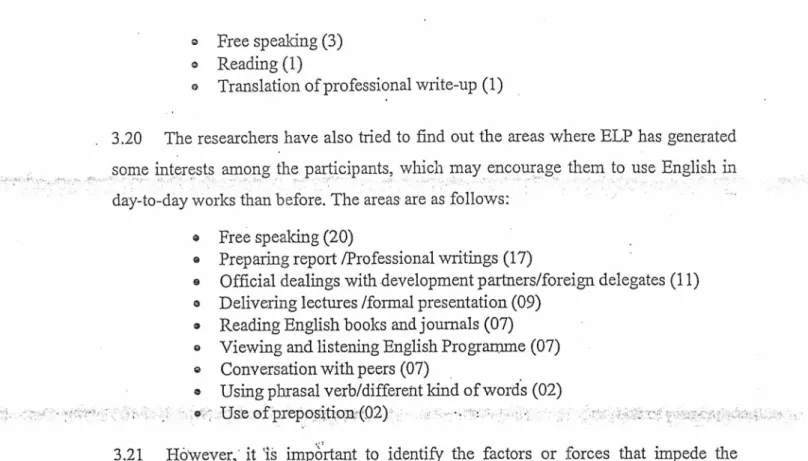
Application of Acquired Knowledge, Skills and Attitudes by the Specified groups of Respondents
Changes in the Content of ELP
- Areas to Improve the Effectiveness of ELP
- ANALYSIS OF FINDINGS
Table-LO: Effectiveness of the training method used in the English language program (in % and in median). Although the researchers did not attempt to analyze the respondents' job descriptions, it would not be unreasonable to say that the majority of respondents need English in their workplaces. Figure-2 shows that a significant number of respondents (73%) did not participate in IELTS/TOEFL exam before participating in ELP.
Therefore, it would not be unwise to say that the selection of respondents was rational to find out the post-training outcome of the ELP of Fl'Cs.
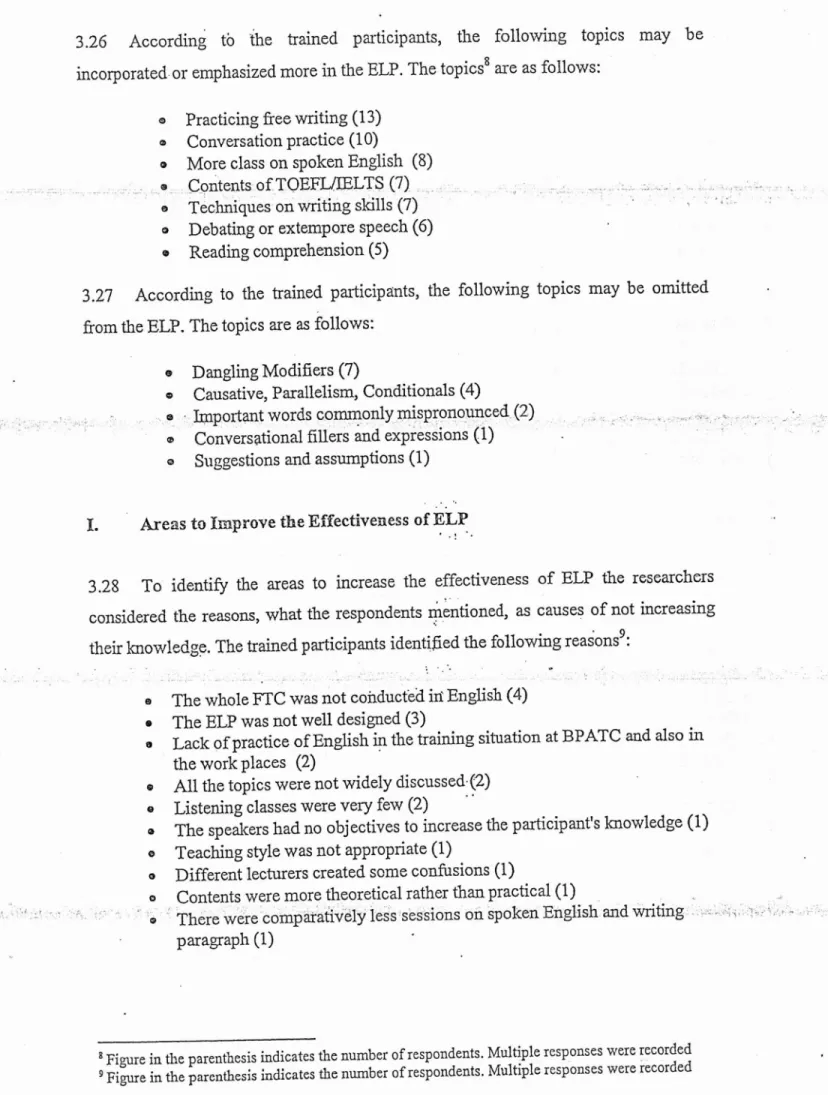
Objectives of the Study
Figure 3: Comparison between knowledge and skills levels before and after training under four main categories (in%). Figure 3 clearly shows that under each main component the knowledge and skills level has increased on average from 11 to 14 percentage points. The researchers also identified some areas where some immediate positive changes in participant attitudes towards English had occurred (Para-3.15).
Table 2 (row 1) shows that the average achievement of one of the FTC's objectives, related to ELP, is 70 inches. The moderate and satisfactory degree of achievement of the objectives indicates that at least some individual improvement of the objectives participants have taken place. But at the same time, the deterioration of the assessment from the course time to the posttraining time indicates that the output chain of ELP decreases as it moves from individual situation to work situation.
Table-V of Appendix-B (Columns 6 and 9) clearly shows that the trained participants applied their acquired knowledge and skills much less than what they acquired. Table-6 shows that 13% of participants were fully successful and 70% of them were partially successful in applying. Researchers have also discovered the areas where they are using their acquired knowledge and skills (Para-3.19).
But at the same time it is clear from Table-V of Appendix-B (Columns 3, 6 and 9) that the ELP result chain is lost as it moves from the individual situation to the day-to-day work situation. The researchers have also highlighted the areas (Para-3.23 and 3.24) where group one and group two respondents are using their acquired knowledge and skills in English. The reason may be that group one respondents have relatively more opportunities to use English in their workplaces than the workplaces of other cadre officers in group two.
The researchers also identified topics that could be included or emphasized more or omitted to increase the applicability of the EDP (paragraphs 3.26 and 3.27). 4'.10 Researchers have explored areas that could be considered to increase the effectiveness of ELP (paragraphs 3.28 and 3.30). Researchers have also found that the effectiveness of the training methodologies used in ELP is.
Conclusion
Achievement of knowledge after application of acquired knowledge FTC (in%) ;-o, FTC (in% , · in daily activities (iri %). The figure in brackets indicates the median. To measure the physical and mental fitness of the participants so that they can handle heavy professional responsibilities. Mcn.ciure:'l must be taken to ensure the equal participation of all involved in the Syndicate Program.
While selcc;ling the syndicate group tile academic background of Ilic members of; group 'Should be considered.
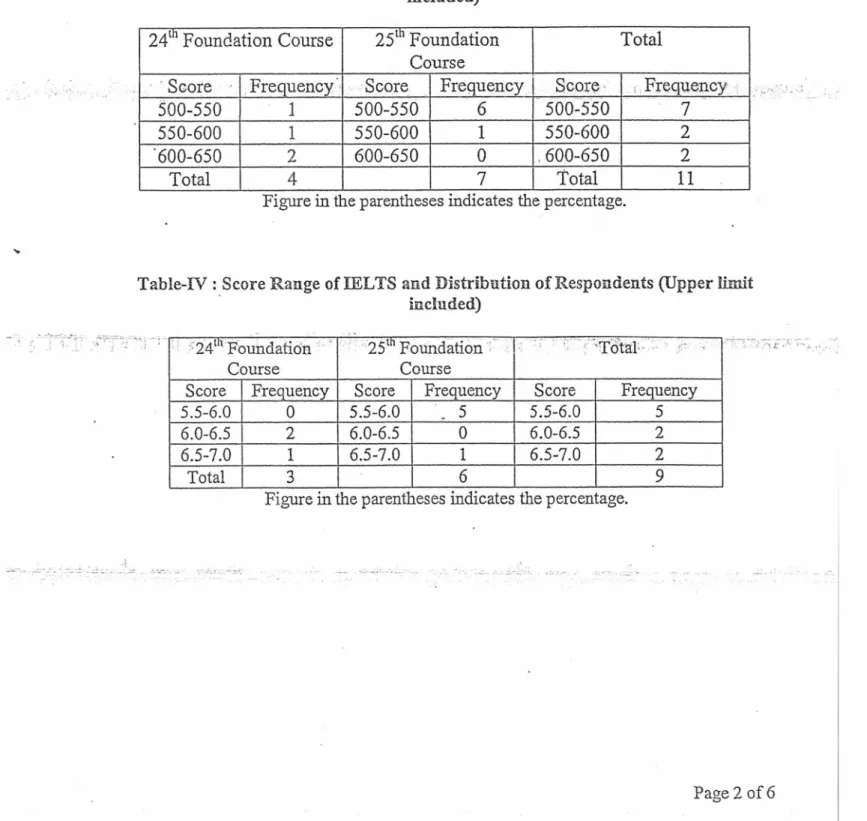
Secretariat Attachment can be reduced to one day or attachment hours can be reduced for.
